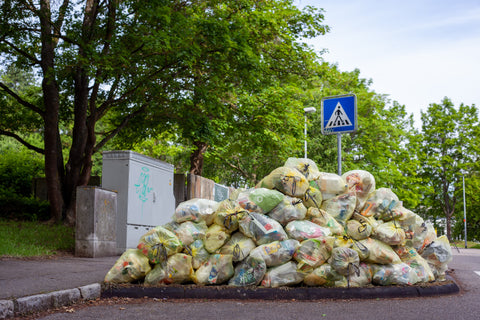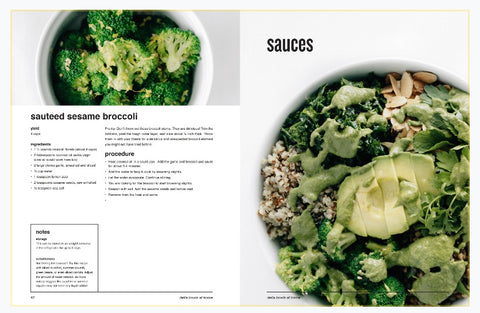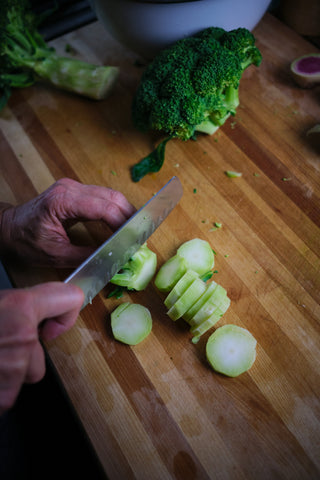Reduce your food waste with these 7 helpful tips
Food for thought
Question: How much food do you throw away in your house every day?
Include food scraps, unused leftovers, and spoiled food.
You might not even think about the food scraps part, since that piece naturally feels like "trash." But, it is FOOD and it does go to waste.
Food spoils for a number of reasons, but most likely, it's a combination of poor planning, over-buying, mismanagement of storage, a cluttered refrigerator, scheduling, and under-utilization of leftovers. We get busy, we change plans, we forget what's hidden in those shelves, we get tired of eating leftovers.
If you're like us, it's absolutely heartbreaking to throw away perfectly good food that simply went bad.
Food goes bad, gets tossed, and ends up in landfills rather than in hungry mouths and bellies.

You're not alone. This is happening in homes across the U.S.
Food waste is a real issue.
80 billion pounds of food waste goes to landfills every year in the US. That's the equivalent of 1000 Empire State Buildings! (Kinda hard to imagine, right!?)
Nearly 40% of the US food supply is wasted each year.
43% of that food waste comes from homes.
That's pretty insane when you think about how prevalent food insecurity is in this country.
37 million people in America are starving, 11 million of whom are children, and meanwhile, we are throwing away 80 billion pounds, or 40%, of our food to landfills.
Not only are we wasting food when there are hungry mouths to feed, but the food ending up in the landfill is a problem in and of itself. Food production on the front end causes 26% of greenhouse gases emitted into the atmosphere, and 6% of emissions come from food waste.
Landfills are the largest human-made contributor of methane into the atmosphere. When organic waste ends up in a landfill, and it's filled and covered without access to oxygen, the decomposition produces methane gas.
Methane is a greenhouse gas that is, over the course of 20 years, 72 times more potent than CO2.
Food waste is a huge problem on many levels, from poverty and hunger, social inequality, environmental pollution, to climate change.
Reduce food waste at home. Be part of the solution.
Change begins with you, and it begins at home. The following are 7 tips to help you better manage food waste in your kitchen.
Start with becoming more mindful and deliberate with the process. Look at it from a holistic perspective, from the planning piece to the final act of discarding waste.
Plan ahead. Purchase wisely. Store effectively. Use food in a timely and strategic way. Get creative. Preserve foods before they spoil. Compost scraps.
This all might seem overwhelming at first, but perhaps try with one or two steps this week. As you feel the satisfaction of doing your part to close the loop, you can add more of the steps to your weekly routine.
1. Plan ahead.
Make a weekly menu and a shopping list, and stick to it.First, take inventory of your food. See what produce needs to be used first, and plug that into the menu for days 1 and 2. Or use it in soups, sauces, or dressings that can be eaten during the week.
Then add in meals for days later in the week that incorporate new items.
Plan for lunches to incorporate leftovers, or actually schedule in a "leftover night." Keeping one meal a bit looser gives you the flexibility to mix and match leftovers from previous meals.
Create a shopping list based on the menu. Stick to that.
Plan to cook the items that spoil first earlier in the week. Leafy greens, fresh herbs, and delicate produce should be used ASAP, whereas heartier ingredients like root veggies, cruciferous vegetables, and squash can last longer.
Try meal prepping!
Plan out your meals for the week, shop for the ingredients, then cook 3-5 days worth of meals at once.
You'll be all set for dinners.
And, for lunches, use a combination of the remaining unused ingredients and leftovers to create healthy bowls of happy.
Keeping a supply of pre-prepped, simple, mix-and-match favorites will not only reduce your food waste, but will be an easy go-to that will leave your body, mind, and pocketbook healthier.

For more guidance on meal prep, and recipes to mix and match, check out the della bowls at home digital cookbook.
2. Get creative with leftovers.
Have fun mixing and matching left-overs to make interesting & delicious meals.
At my house, we always make more than enough with the intention of having a few leftovers. After meals, leftovers get stored in the fridge for combining in future meals.
A few of my favorite ways to use leftovers:
Make a della bowl!
Start with a base like a hearty grain, zoodles, spaghetti squash, or mixed greens. Add a scoop of protein. Layer in a combination of cooked and raw veggies. Drizzle generously with a sauce or dressing. Top it with a boost like creamy avocado or crunchy seeds or nuts. Arrange it in a color wheel for presentation, then mix it all up and devour!

Veggie fried rice
Take leftover veggies and cut them up small. Saute with minced garlic and ginger until cooked (this won't take long if you're using cooked veggies). Add cooked rice. Sauce it with soy, teriyaki, curry sauce... or della bowls gold sauce if you have it.
Curry in a hurry
Left-over veggies and proteins can be added to a pot, then combined with coconut milk and curry powder or Thai curry paste. Let simmer together for at least 20 minutes. Add some fresh cilantro at the end. Serve over rice or quinoa.
Big, hearty salads
Leftover grains, veggies, and proteins can be mixed together for a quick and satisfying entree salad. Think quinoa or rice + roasted veggies + greens or raw veggies + sautéed tempeh or tofu + chickpeas or cooked lentils + sauce or dressing.
3. Store your food for optimal freshness
Improper storage leads to food waste, as does a cluttered and over-packed fridge. When you don't rotate foods with a first in-first out system, and the fridge is full, items in the back and in the drawers beneath go bad before we even know they're there.
Many foods don’t need to be refrigerated. Don't waste precious real estate in the refrigerator with these counter-friendly foods: potatoes, tomatoes, cucumbers, onions, garlic, and citrus.
Separating your foods also makes a difference. Some foods produce more ethylene gas than others, causing foods around them to ripen or spoil faster. Foods that release ethylene gas include: bananas, avocados, tomatoes, cantaloupes, peaches, pears, and green onions.
Foods that should always be refrigerated and which are especially sensitive to ethylene gas include apples, leafy greens, peppers, and berries.
4. Use the whole veggie
Do you keep the crowns, but discard the broccoli stems? What about celery leaves? Stems of herbs? Do you peel and throw away the most nutritious part of the root vegetable?
You may be trashing perfectly good produce … maybe even the most flavorful part of the veggie… without knowing it. What a waste!
Try these hacks:
Next time you make broccoli, cut the stems from the crowns. Reserve the crowns for a later date. Trim the bottom of the stems. Peel the tough outer layer. Slice thickly and toss with olive oil, salt, pepper, and dried herbs of your choice then roast at 400 degrees for about 20 minutes. You can also slice it thinly, and sauté in olive oil with sliced garlic. Add salt, pepper, and lemon zest to finish.

Don’t toss those celery leaves! Finely chop the tops of the celery to add into salads or to garnish soups. The celery leaves are beautiful and they impart a delicious grassy flavor to foods.
Most recipes call for the leaves of parsley, cilantro, and basil. But, the stems have a ton of flavor! They can be used in blended pestos and chimichurri, dressings, pureed soups, and more! Use them in stocks to add more flavor and nutrition.
Many root veggies like radishes, beets, and carrots come with their tops still attached. These are power-packed greens that can be delicious when sautéed with some garlic and olive oil.
Don't trash those peels!
Foods that grow in the soil, especially root veggies like sweet potatoes, carrots, beets, turnips, etc, take on the nutrients in the soil. That’s one reason to make sure the soil is free of chemicals and pesticides.
It also means that the skin of these veggies contains a lot of those great nutrients and can contribute to the healthy microbiome in your gut.
Don’t peel those veggies! Not only is it wasteful and unnecessary, but you’re also throwing away the best part of the vegetable! Eat the skins, reduce waste, and reap the nutritional benefits.

5. Creatively use foods before they spoil
Gazpacho. Vegetable soup. Sauces. Dressings. Think outside the box.
You realize that you have a bunch of veggies that need to be used up in a hurry... what to do?
Make a gazpacho!
- Throw a bunch of different veggies into the blender, ie. tomatoes, green onion, white or red onion, cucumbers, green and/or red bell peppers, jalapeno, zucchini, spinach, fresh herbs like basil, cilantro, or mint.
- Use garlic sparingly.
- You can add avocado, but not if it’s going bad. An over-ripe avocado can ruin the entire batch of gazpacho.
- Consider adding watermelon too!
- After adding all the veggies, add olive oil, apple cider vinegar, salt, and pepper.
- If there are a lot of hard vegetables, and not enough watery ones, you can also add the veggie stock.
Or...
Make a veggie puree soup!
- Saute onions and garlic in olive oil until soft.
- Add in chopped veggies and saute.
- Alternatively, you can add cooked veggies like roasted or grilled veggies.
- Add stock and bring to a boil. Reduce to a simmer and cook for about 30 minutes, until veggies are very soft.
- Season to taste. Add fresh herbs, if desired.
- Blend well.
6. Preserve, ferment, or freeze food
Preserve foods that you know you won’t get to use
- When berries, bananas, and other fruits are getting too ripe, don't trash them! They can be peeled, cut, and frozen for future smoothies, banana bread, blueberry muffins, and other delicious recipes.
- Veggies can be easily fermented by adding sea salt and a mix of garlic, ginger, herbs, and spices. The most simple fermentation process is to mix hard veggies with 32 ounces of water, 2-3 tablespoons sea salt, garlic, and herbs. Let them sit in a covered jar with a little air to breathe on the counter at room temp, "burping" them occasionally. After a week, they are ready! Read more about lacto fermentation and find an awesome recipe here.
- Preserve fruits and/or veggies by making a jam or chutney.
- Pickle veggies like cauliflower, cucumbers, radishes.
Don't throw out those leftover veggies from your party platter! Turn them into counter-top kimchi.
7. Compost food scraps
Sounds scary? Worried about pests or foul smells? Live in a small space?
All valid excuses... but it's not as hard or scary as it seems... and can make a great environmental impact. It also connects you to nature in a very real way.
Debris Free Oceans, a Miami organization dedicated to inspiring zero-waste lifestyles, hosted an awesome webinar/ workshop that focused on food waste and composting.
Five panelists broke down composting to make it simple and fool-proof. From the basics of backyard composting to strategic scrap placement for small spaces to using worms to create nutrient-rich soil... this workshop had it all!
Panelists and what they discussed included:
- Sanna from Miami Botanical Gardens talked about community garden compost projects
- Sofia Mesa of Debris Free Oceans discussed strategic scrap placement in small areas/
- Shannon and TJ of MORAES dove into the stepts to making a simple backyard bin
- Caiti Waks of Debris Free Oceans told the ins and outs of a tumbler
- Lina Castenada of @minima.lina speaks about worm composting
Find the slides from the event here.
Do something.
Start with one thing, and make goals to add more of these practices in time. Little by little, you can reduce your food waste in your home, and become part of the solution.
To recap...

We’ve linked some of our tried and true cooking tools and culinary products recommended here to our The Doral Yard Favorites store on Amazon. As an Amazon Associate we earn from qualifying purchases.

